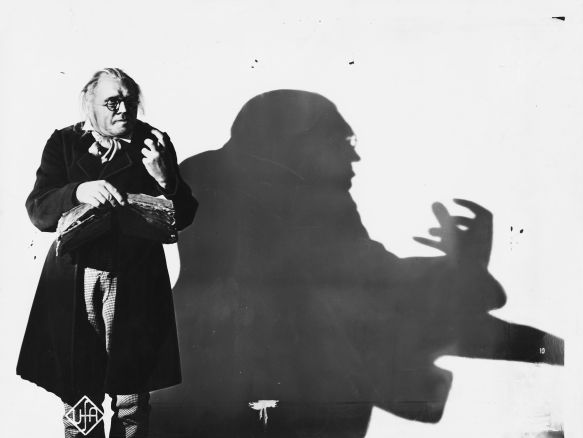
Das Cabinet des Dr. Caligari (G 1919, directed by Robert Wiene)
Light and Shadow – On the Film Set of the Weimar Republic
23.1. – 27.4.14
The exhibition “Light and Shadow. On the Film Set of the Weimar Republic” is a photographic journey of discovery situated within an especially creative phase of German film history. The aftereffects of World War I and the fragility of the young democracy, the absurdly rapid tempo of the new era, the realities of daily life, but also the negative utopia of an uncertain future – all of these aspects were illustrated through artistic means in German feature films before 1933, and were passed on to subsequent generations. Films such as Das Cabinet des Dr. Caligari, Nosferatu, Die freudlose Gasse, Metropolis and Der blaue Engel set new standards for international cinema. This important chapter of German film history ended abruptly with Hitler’s rise to power: Directors like Fritz Lang, Robert Siodmak and Max Ophüls, authors like Walter Reisch, Curt Siodmak and Billy Wilder, cameramen like Karl Freund, Franz Planer and Eugen Schüfftan, were no longer allowed to pursue their careers, because their Jewish origins banned them from working. Many film professionals emigrated to the USA, taking their know- how, their ideas and their traditions with them – where they presented them to the world.
The exhibition “Light and Shadow” is dedicated to the most important films of the Weimar Republic. It is an homage to the art of film photography. The relationship between film, cinema and photography has always been very intense, because film needs photos for its self-representation. All of its beauty and imagination, its artistry and popularity would not be conceivable without the reproduction of images in newspapers, journals and magazines, in display cases and on the façades of movie theaters. Films use still photographs, star portraits and visual self-references to their advantage. That’s why still photographers accompany production on the set. They are supposed to illustrate the highlights of the stories being narrated, and especially the protagonists. Both the scenes and the stars must look enticing, since the photos are intended to make potential viewers curious. The photos on display in the exhibition are originals from the archives of the Deutsche Kinemathek.
The exhibition, curated by Hans Helmut Prinzler, was conceived in cooperation with the Versicherungskammer Bayern and was shown at the Kunstfoyer VKB in Munich from 2012-13. The accompanying catalogue, Licht und Schatten (only in German), published by Schirmer/Mosel, is available for 29 € during the exhibition.
Gallery
-
The exhibition
Photo/©: Marian Stefanowski -

The exhibition
Photo/©: Marian Stefanowski -

The exhibition
Photo/©: Marian Stefanowski -

The exhibition
Photo/©: Marian Stefanowski -

The exhibition
Photo/©: Marian Stefanowski -

Nosferatu (G 1921, directed by Friedrich Wilhelm Murnau)
Source: Deutsche Kinemathek -

Schatten (G 1923, directed by Arthur Robison)
Source: Deutsche Kinemathek
Credits
Artistic Director: Dr. Rainer Rother
Curator: Hans Helmut Prinzler
Project management: Peter Mänz, Kristina Jaspers
Project management at the Kunstfoyer VKB, Munich: Isabel Siben
Texts in the accompanying brochure: Hans Helmut Prinzler
Exhibition coordination: Vera Thomas
Audiovisual media program: Nils Warnecke
Exhibition assistance: Wolfgang Theis, Julia Riedel, Georg Simbeni
Text editing: Rolf Aurich
English translations: Wendy Wallis, transART, Berlin
Design of the advertising graphics: Pentagram Design, Berlin
Design of the exhibition graphics: Jan Drehmel, befreite module, Berlin
Production of the exhibition graphics: Bartneck Print Artists, Berlin and
PPS Imaging GmbH, Berlin
Exhibition design: Rüdiger Stern, stern-gestaltung, Berlin
Conservational supervision: Sabina Fernández, Berlin
Media and lighting installations: Stephan Werner
Technical services: Frank Köppke, Roberti Siefert
Communications: Sandra Hollmann
Marketing: Linda Mann
Press: Heidi Berit Zapke
Museum education and mediacy: Jurek Sehrt
Finance: Uwe Meder-Seidel
Acknowledgments
Special thanks to all of our colleagues at the Deutsche Kinemathek – Museum für Film und Fernsehen
Partners
In cooperation with
Versicherungskammer Bayern. Sparkasse Finanzgruppe
Partner
Friedrich-Wilhelm-Murnau-Stiftung
Media Partner
epd Film Das Kino-Magazin
The Deutsche Kinemathek is supported by
The Federal Government Commissioner for Culture and the Media
through a resolution of the German Bundestag